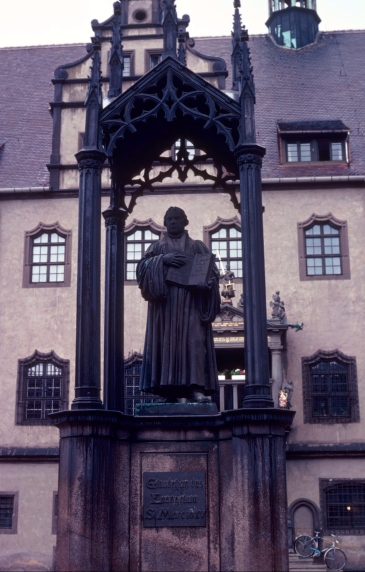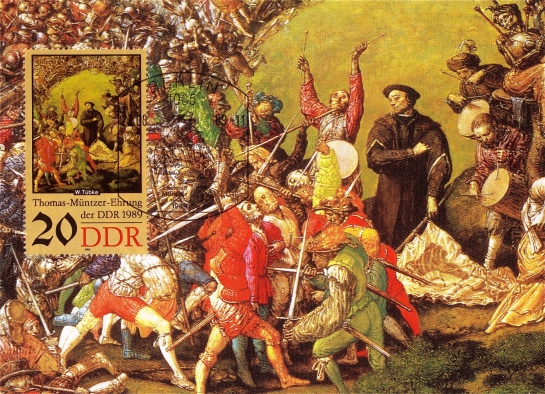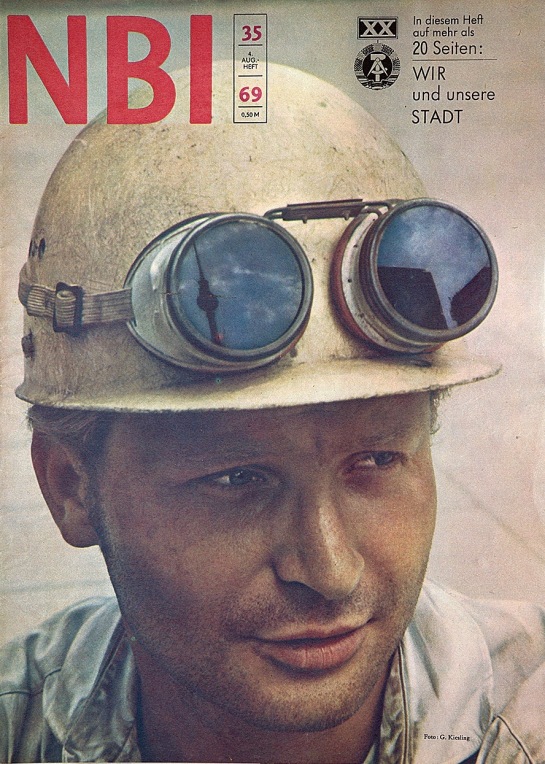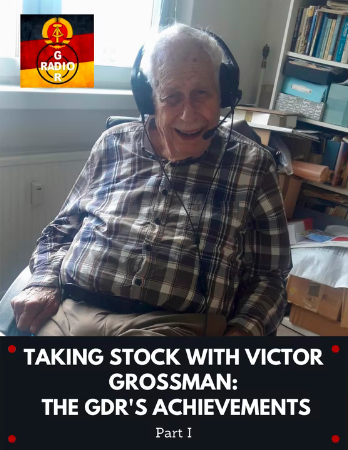I recently had the chance to speak with Victor Grossman, an American Communist who defected to the East Bloc at the height of the “Red Scare” in 1952, for the Radio GDR podcast. Once on the other side of the Iron Curtain, he found himself in the GDR, a country that would be his home until it ceased to exist in 1990. While a strong supporter of “the socialist project”, Grossman is clear-eyed about the GDR, its achievements and shortcomings.
Read MoreTag Archives: Erich Honecker
Field Trip: Neues Deutschland (Berlin/Friedrichshain)
In May 2019, The GDR Objectified ventured to Berlin’s Friedrichshain district to seek out the building housing Neues Deutschland (New Germany), a left-wing daily newspaper founded as the official organ of the GDR’s ruling Socialist Unity Party (SED). Join us as we seek out remnants of the East German past on site and explore the paper’s history.
Erich Honecker, “The Grave Digger of the Nation” and 1983

Statue of Martin Luther, Wittenberg Town Square, spring 1980 (photo: D. Hendricksen)
As today is Reformation Day, it seems an appropriate moment to turn our attentions to the GDR’s relationship to Martin Luther (1483 – 1546), the German theologian generally credited with having been one of the key figures in setting this transformative process in motion.
“Grave digger of the nation”, “servant of the princes”: these were but two of the epithets popularly directed at Luther by East German ideologues and cultural leaders, at least in country’s early years. Hewing close to a Marxist-Leninist reading of German history, GDR historians understood Luther as the “seed of the German misery” which would later blossom into fully formed disaster with Adolf Hitler and the Nazis.
While this position softened somewhat by the mid-1970s and some of Luther’s contributions to German culture came to be grudgingly acknowledged by the Socialist Unity Party (SED) apparat, the reformer remained nevertheless an ambivalent figure in East German cultural life. That is, until 1980 when East German leader Erich Honecker labelled the medieval monk “one of the greatest sons of the German people.” (pg. 3. Berliner Zeitung, June 14-15, 1980) It was a reassessment which caught many, in particular his SED comrades, off guard.
What was behind this change and what were the results?
The Final Victim of the Berlin Wall: Chris Gueffroy
Today is a good day to reflect on the victims of the years of German division, in particular those whose lives were lost at the Berlin Wall, as it was on this day 28 years ago that a 20-year old East Berliner named Chris Gueffroy became the final victim of the “order to shoot” in effect at the border separating the two Berlins. Gueffroy was shot to death trying to make his way across the border fortifications separating the East Berlin district of Treptow and the Neukölln neighbourhood on the West Berlin side. The pair had chosen this evening to try and make their escape in the mistaken belief that a visit to East Berlin that day by Sweden’s Prime Minister had resulted in the temporary suspension of the “order to shoot”. This had been the case, but by the time of their attempt, the Swedish PM had left town and it was back to “business as usual” at the Wall.
I happened to be studying German in West Berlin at the time of this incident and I remember it as a moment which underscored for me just how cold the Cold War had left many West Berliners. Read More
State of the Art and the Art of the State – Panorama Museum, Bad Frankenhausen

First-day issue postcard from Deutsche Post in honour of Reformation-era revolutionary “Thomas Müntzer” with an excerpt from Werner Tübke’s masterpiece, Early Bourgeois Revolution in Germany, as found in the Panorama Museum, Bad Frankenhausen.
From the outside, it looks like nothing so much an 80s-era sports arena that has been placed quixotically atop a small mountain in the Thuringian countryside. However, the Panorama Museum in Bad Frankenhausen is in fact one of the few manifestations of GDR cultural policy to have survived the transition to a unified Germany essentially intact. The museum houses one item, a massive panorama-style painting by East German painter Werner Tübke which bears the name Early Bourgeois Revolution in Germany (Frühbürgerliche Revolution in Deutschland). Measuring 123 m in length by 14 m high, this monumental work includes scenes from the German Peasants’ War, a series of uprisings that took place across German-speaking Central Europe between 1524 and 1526 and which leaders of the Socialist Unity Party (SED) were eager to present as an historical antecedent to their “Workers and Peasants’ State”. Indeed the clear ideological intent with which the Panorama Museum was created makes its continued existence all the more remarkable.

Panorama Museum above Bad Frankenhausen (Goertz Verlag, 1985).
Neue Berliner Illustrierte: It’s a lot like LIFE
One of the GDR’s most popular magazines was the weekly Neue Berliner Illustrierte (New Berlin Illustrated), a bright and colourful publication which, with its mixture of politics, portraits, social trends, sport and culture, resembled nothing so much as that iconic chronicler of American society and politics LIFE.

Issue #35 of the NBI in 1969, the 20th anniversary of the GDR. The cover story focused on the construction of the “new, socialist Berlin” (photo: R. Newson).
NBI was older than the GDR itself, first appearing already in 1945 during the early months of the Soviet occupation. Over the years, the magazine enjoyed considerable popularity and by the end phase of the Workers and Peasants’ state, NBI had a weekly circulation of 800,000 issues. While such numbers are perhaps not the most reliable measure of popularity in a command economy (well, beyond a publication’s popularity with those in charge), the NBI “was sought after just like all other bright and glossy magazines in which there was less propaganda” (“Amboss oder Hammer sein” by Christoph Dieckmann, ZEIT, November 1, 1991). Read More
With Friends Like These: The Society for German-Soviet Friendship
In the late 1940s, it was by no means certain that Joseph Stalin’s careful calculus of the Soviet Union’s best interests in regards to their German zone of occupation (SBZ) would result in the establishment of a client state. However, once Stalin had decided to proceed down this path and allow the Soviets’ allies in the Socialist Unity Party (SED) in East Berlin to found the German Democratic Republic, Soviet support served as the bedrock guaranteeing the existence of the “Workers and Peasants state”.
For the GDR’s leadership cadre this close alignment to the Soviet Union was something to be welcomed. Practically all of these individuals had been inspired to join the Communist movement by the Great October Revolution of 1917 and many had spent the twelve years of Nazi rule taking refuge in the Soviet Union. The result of these experiences was an ideological and emotional bond with the Soviet Union that ran very deep. The vast majority of East German citizens, however, were not as positively predisposed towards the Soviet Union as their leaders, a fact that posed a significant challenge to both the GDR and Soviet authorities.
It was against this backdrop that in 1949 the Soviet Military Administration in Germany approved the founding of the Society for German-Soviet Friendship (Gesellschaft für Deutsch-Sowjetische Freundschaft (DSF)), an organization mandated to foster a deeper knowledge of and appreciation for Soviet culture and history among East Germans.
Marzahn: The Pros and (All The Mod) Cons
Anyone with an interest in the GDR quickly encounters mention of Marzahn, a massive housing estate located on the northeastern edge of the East German capital Berlin. Made up of approximately 60,000 prefabricated concrete apartment units housed largely in high rise tower blocks, Marzahn was built over approximately fifteen years beginning in the mid-1970s to provide modern housing options for tens of thousands of East Berliners. Supporters of the socialist system saw the district as concrete evidence (I couldn’t resist!) of the state’s commitments to its citizens’ welfare and a tangible example of what the socialism could achieve. For critics, however, Marzahn’s seemingly endless blocks of anonymous, monotonous apartment blocks recalled the sort of dystopian world conjured up George Orwell in his totalitarian critique 1984.
While I didn’t get to Marzahn during the GDR era, I’ve had the chance to visit a view times over the past twenty years or so and been able to see first hand some of the remarkable changes that it has undergone since reunification in 1990. Before turning to my impressions, however, allow me to present a brief history of the district.
Marzahn: Heaven or Hell?
- Berlin – Marzahn; This postcard presents Marzahn, an Berlin housing estate and the largest of its kind in the GDR (Bild und Heimat, 1989).
- Marzahn by night, December 1985 (photo: Bundesarchiv 183 1985-1219-021)
Read More
Schwedt: “A Sanssouci of Socialism”
East German city planning is a particular interest of mine because here the frictions between the utopian aspects of the socialist project and the concrete realities of daily life in the GDR are revealed in a most telling way. East German leaders were determined to create the “new socialist personality” (their version of the Homo Sovieticus) and saw in city planning another tool to facilitate this goal. At the centre of these efforts were four so-called “socialist cities”, towns planned from the ground up and, theoretically at least, built in such a way as to enable its citizens to live their lives in conformity with the values and priorities of the state’s socialist ideology. Over the past number of years, I managed to visit three of these several times (Eisenhüttenstadt, Hoyerswerda and Halle-Neustadt), but had never made it to the fourth, Schwedt. That changed this past April when I was able to spend a day in this town in the lovely Uckermark region to the north-east of Berlin.
Public Art from GDR Era, Pt. 1
My guide in Schwedt was Dr. Johanna Goldberg, a resident of the town since 1969 and someone who will be familiar to regular readers as the subject of several recent posts. My hope was that she would be able to give me a personal take on Schwedt’s history and I was not disappointed. Before heading out for my tour, however, I gave a close read to Dr. Philipp Springer’s Verbaute Träume: Herrschaft, Stadtentwicklung und Lebensrealität in der sozialistischen Industriestadt Schwedt (Blocked Dreams: Power, City Planning and Daily Life in the Socialist Industrial Centre of Schwedt – Ch. Links Verlag, 2006), a detailed look at the development of this “socialist city” and source of many of the facts laid out here. Read More
They were the people! – November 4th Demo in East Berlin
Today marks the 25th anniversary of the largest demonstration in the history of the GDR and another important milestone on the path to the toppling of the GDR’s one party state. The demonstration took place on East Berlin’s Alexanderplatz and attracted more than half a million protestors. The demo’s reach was extended by GDR television which broadcast the more than three hour long event live – including boos drawn by Party representatives – to every corner of the Republic.

“We were the people.” – a banner hung on the House of Teachers on East Berlin’s Alexanderplatz in 1999 to mark the Nov. 4th demo.
The demo was approved in the wake of the resignation of Erich Honecker, the head of the ruling Socialist Unity Party, on October 18th and featured a broad spectrum of GDR public figures calling for changes in “the better Germany”. These included civil rights activist Jens Reich, authors Christa Wolf and Stefan Heym, actor Ulrich Mühe (The Lives of Others), Markus Wolf, the recently retired head of the Stasi’s foreign espionage wing, and even Günter Schabowski, the Party boss who would somewhat unwittingly open the Berlin Wall a mere five days later. Read More








